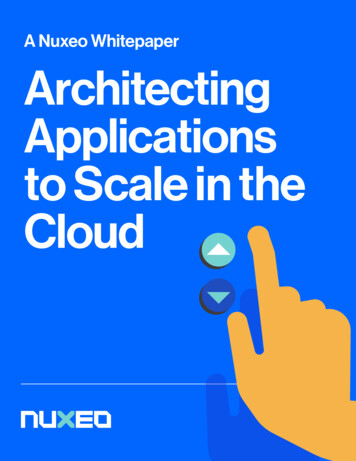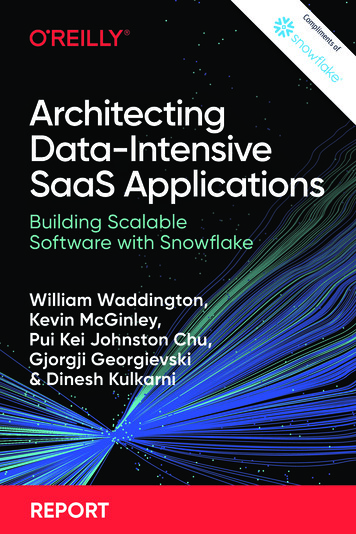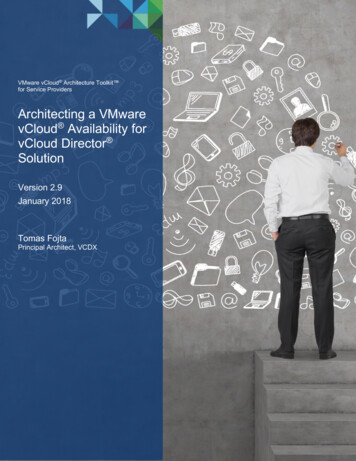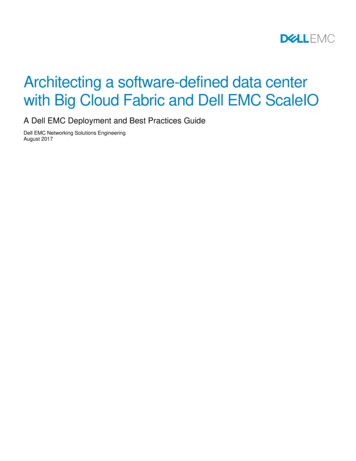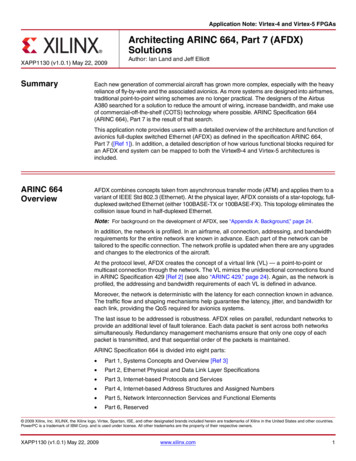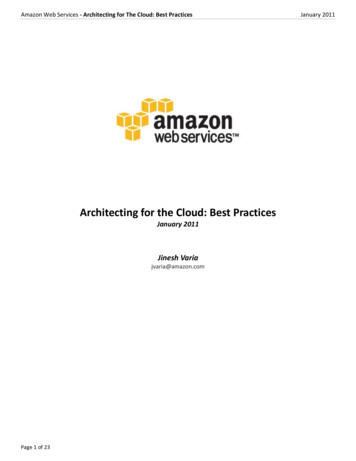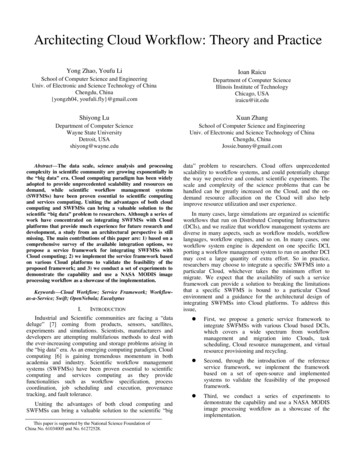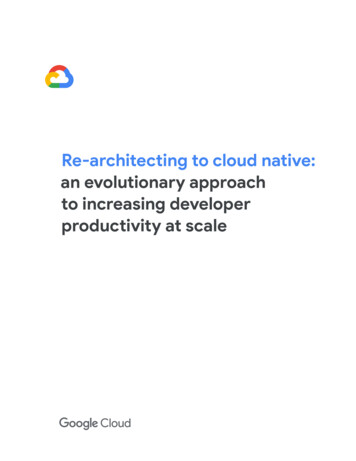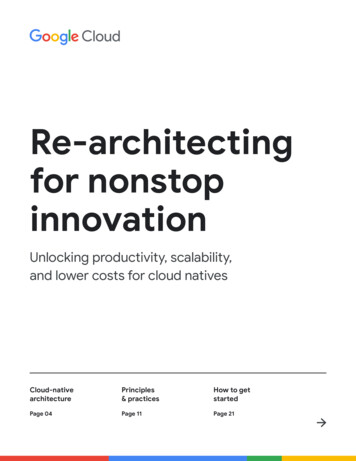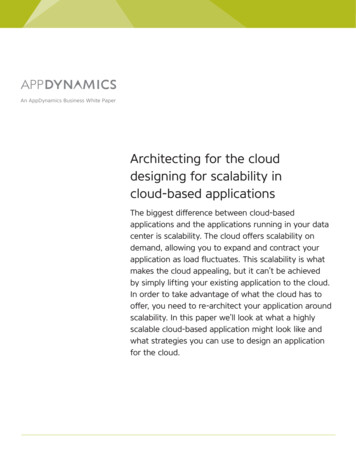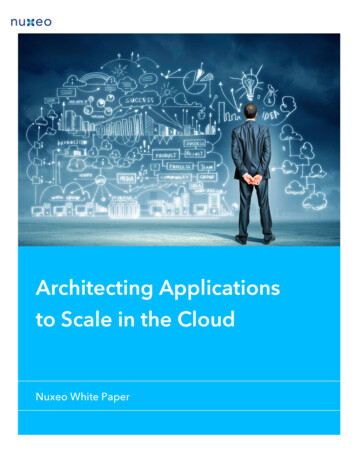
Transcription
Architecting Applicationsto Scale in the CloudNuxeo White Paper
White PaperArchitecting Applications to Scale in the CloudTable of ContentsExecutive Summary . 3Between IaaS and SaaS. 3Nuxeo and AWS . 3AWS for Content Management . 4Architecting Applications for the Cloud . 5Introduction to the Nuxeo Platform. 6Tailoring Apps to Individual IaaS Capabilities . 7Scale Out and Distributed Architecture . 9CPU Scale Out. 10Dedicated Resources and Specific Processing Requirements . 10Storage Scale Out . 12Query Scale Out . 12Scaling Out with Multiple Data Stores . 13Scaling Out with NoSQL . 14Leveraging Cloud Opportunities . 15About Nuxeo . 16Page 2 of 16
Executive SummaryAmazon Web Services (AWS) and similar cloud-service offerings have revolutionized the ways in whichorganizations approach application development and deployment. Through cloud services, organizationscan obtain on-demand—inexpensive, modular infrastructures for deploying virtual instances of networkingcomponents, storage repositories, compute platforms, and management frameworks. As cloud servicescontinue to mature, the Platform-as-a-Service (PaaS) model has been steadily gaining recognition and favor.The abstraction layers provided when using a PaaS model offer a particularly effective means for developersto focus on coding and to implement a variety of business applications efficiently on public clouds. Theseabstractions also relieve administrators of many of the configuration and deployment challenges, as well asmaintaining traditional hardware servers, providing a ready means for self provisioning IT resources, andeasily configuring the PaaS environment through administrative tools and control panels to addresschanging requirements.Between IaaS and SaaSIn a typical implementation, PaaS serves as a partial operating system and middleware, residing in thetechnology stack between an underlying Infrastructure-as-a-Service (IaaS) layer and the Software-as-aService (SaaS) layer that provides a user interface. As discussed throughout this paper, the combination ofAWS and PaaS opens up many advantages and provides numerous mechanisms for developers andarchitects to design, plan, and implement new technologies and prototype new solutions without the costand commitment of traditional computing. Software developers following agile development processeshave the flexibility to move from ideas and concepts through rapid development to a marketable product—swiftly and cost effectively—within a responsive PaaS environment.Nuxeo and AWSUsing a PaaS model optimized for the capabilities and features of AWS, Nuxeo has designed an extensiblemodular framework for handling high-volume document management and complex digital assetmanagement tasks—with high scalability and reliability. This design framework makes it possible fordevelopers to efficiently leverage AWS cloud services and customize the platform for a diverse variety ofrequirements. This paper provides an architectural overview of the fundamental mechanisms for buildingand deploying content management applications on AWS using the Nuxeo Platform.Page 3 of 16
AWS for Content ManagementSince the introduction of Amazon Simple Storage Services (S3) in 2006, AWS has evolved into a powerful,responsive infrastructure that has helped shape the way in which applications are developed and howenterprises handle IT requirements—providing commodity-level access to a full range of cloud services.Several AWS characteristics make it well suited for content management tasks, including: Fast, low-latency content distribution: Delivery of content over the web to end users usingAmazon CloudFront is a fast, cost-effective way for handling everything from streaming video toentire dynamic websites. Through integration with other AWS offerings, such as S3 and EC2, contentdelivery can be optimized to take advantage of Amazon’s global network of edge locations,minimizing latency and boosting performance. As a usage-based service with no commitment, theonly costs accrued derive from the actual volume of content delivered. Content collaboration can behandled efficiently with full access for workgroups spread out across multiple locations. Evenextremely large files, such as those encountered in engineering projects and digital assetmanagement environments, can be delivered securely worldwide—at high speed—to supportcollaborative efforts. Inexpensive, reliable storage: S3, Amazon’s pioneering cloud storage service, continues toprovide value to enterprises that require a reliable, scalable method for storing many kinds of digitalassets in the cloud. Developers gain secure access to object containers, referred to as buckets, thatare addressable by URL, located in a specified geographical region, and scalable to accommodateescalating storage demands. Elastic compute resources: Content-centric applications often place varying demands on computeresources for media processing, handling different levels of user traffic, data migration, sorting andindexing, and other tasks. AWS provides a number of elastic capabilities that can scale to meetdemands, including the capability to scale out virtual servers (EC2), media transcoding (ElasticTranscoder), perform Auto Scaling, and adjust load balancing (ELB). Proven work environment: AWS has refined and enhanced its cloud service offerings over manyyears to ensure a secure and reliable work environment for the mission-critical applicationsencountered in content management operations. Important features are available and accessible,including database snapshots, automated load balancing, key performance metrics, high-volumebandwidth availability, monitoring, and so on.Other AWS capabilities support content-centric applications very effectively. For example, disaster recoverycan be accomplished rapidly using failover techniques, minimizing downtime and potential enterpriselosses from business interruptions. In digital asset management scenarios, back-end processing nodes canbe separated from front-end servers so that the scaling of images and video processing can be handledmore efficiently.AWS provides a capable IaaS framework for new-generation digital asset management projects, distributedcontent collaboration, and global content distribution.Page 4 of 16
Architecting Applications for the CloudSimply porting traditional applications over to a cloud platform is unlikely to be successful, resulting innumerous operational and performance issues. Architects and developers knowledgeable about cloudservices recognize this and take measures to avoid the problems. To take full advantage of a cloud-servicesenvironment, whether IaaS, PaaS, or SaaS, the key to success entails understanding the limitations of theenvironment and then effectively leveraging the built-in advantages. Designing an application from theground up—the best way to build apps for the cloud—requires that developers adopt a different mindsetand master a new paradigm.For example, architecting an application that can rapidly adapt to high volumes of transactions and avarying number of users typically requires that developers create a large amount of code to handle thedemands of scaling, which might include caching, database scaling, asynchronous messaging, and so on. Awell-designed PaaS platform will already be optimized with built-in capabilities for these functions. Insteadof writing code, the developer can simply tap into the appropriate functions as needed.General guidelines for architecting applications for availability in the cloud include: Anticipate failure: Be aware of the possibility that parts of the cloud may sometimes fail. Design andtest applications for resiliency and the ability to respond to failures. Componentize applications sothat multiple modules that communicate with each other through an API can recover independently,if necessary. Data sharding, application sharding, and multiple deployments of critical componentsare useful in this regard. Employ stateless computing techniques: Using stateless protocols, such as IP and HTTP,eliminates the possibility that a state stored in memory will be lost due to an outage or serviceinterruption. Because the internal state of an application won’t be available as conditions change orfailures take place, store these states in an object store, database, or message queue. When scaling, scale out: Scaling up in a cloud-based environment always runs the risk that anapplication will run out of resources (for example, scaling up a database beyond the constraints ofthe server performance on which the database is running). Scaling out horizontally is much moreeffective, offering essentially unlimited scalability that takes advantage of elasticity of cloudresources. Keep data consistency in mind: Because there can be multiple instances of an application residingin different geographic regions, some changes in the database or the application may not bereflected for a number of milliseconds. To maintain a model where data is replicated and highlyavailable within this environment, developers must devise an approach that handles potentialinconsistencies when different application instances draw from the same database. Data shardingbased on different geographic regions is one way to accomplish this.Page 5 of 16
Use event-driven behaviors: Synchronous calls that require timed responses typically don’t workwell in the cloud. Instead, code applications to be event driven, responding to actions from thesystem or individual users. To maintain high availability in the cloud, create a queue for requests thatcan be processed by different application instances. This can boost performance and minimizelosses to a single transaction if an application instance fails.Investigate the specifications of the PaaS that you select to fully understand the capabilities and feature setas you begin development. In the case of the Nuxeo Platform, even if your application requirements aremodest, such as basic document management or asset management that includes workflow processes,built-in cloud-aware capabilities that have been architected into the product can save considerable timeand effort, as well as improving the reliability of your application. Nuxeo also frequently updates theplatform to include new features and capabilities, so that as cloud service technologies evolve, architectsand developers can take advantage of the latest enhancements.Useful references on this topic include: Open Data Center Alliance: Architecting Cloud-Aware Applications Architecting the Cloud: Design Decisions for Cloud Computing Service Modes (SaaS, PaaS, andIaaS) Architecting Applications for the Cloud: Best PracticesIntroduction to the Nuxeo PlatformThe Nuxeo Platform, when coupled with AWS and the available toolset, provides a comprehensive,extensible Platform-as-a-Service, readily adaptable to business application development. Through theefficiencies of operating tightly with AWS, the Nuxeo Platform enables architects and developers to easilybuild and run content-focused business applications that can handle extremely large document sets (evenat volumes ranging into the billions).Several pre-built applications are included, allowing development teams to quickly deploy and launch anumber of fully featured content-management tools or customize these applications to meet specificrequirements. These modern technologies, powerful plug-in model, integrated development environment,and flexible packaging capabilities make the Nuxeo Platform an ideal environment to rapidly design,develop, and deploy applications, on premises or within a cloud environment.Nuxeo Platform supports the creation of end-to-end workflows—through a graphical interface— forperforming content-management processes. Alternatively, applications can be built within the integrateddevelopment environment, accessing the exposed functionality in an API that supports the representationalstate transfer (REST) model.Page 6 of 16
Tailoring Apps to Individual IaaS CapabilitiesCapabilities and functionality of individual IaaS offerings vary. For maximum efficiency, interoperability, andperformance, when building applications to run on top of an IaaS framework, developers gain manyadvantages by exploiting the built-in features, components, and capabilities available.The infrastructure offered by the cloud provider typically: Includes components that are fully integrated and tested for interoperability Features mechanisms for manual or automated scaling of virtual servers, storage, network resources,and other system resources Provides an easy way to monitor ongoing costs by usage, with billing limited to those computeresources that are used Costs substantially less to use than comparable on-premises systemsAs a developer, when architecting a solution to deploy in an IaaS environment, you should: Rely as much as possible on open standards, as well as industry standards that are widely accepted.o IaaS frameworks are more likely to provide a SQL Database than a RDF Graph databaseBuild solutions based on a pluggable architecture.oA pluggable architecture lets you adapt your application to the new infrastructure more easily.oTypically, to leverage the cloud infrastructure, you will need to modify some of theapplication’s low-level implementation.The Nuxeo Platform supports both a standards-based architecture and pluggable component model(Extension Point). Nuxeo is well suited for leveraging the AWS infrastructure, featuring: Meta-Data Store: Oracle RDS or PostgreSQL RDSo Binary Store: S3 Binary Storeo Native plug-in is provided (not specific to AWS).A pluggable BinaryManager is used to leverage the S3 storage capabilities.Cache: ElasticCache / RedisoThe pluggable cache infrastructure supports Redis.oDistributed Job queuing has been based on Redis for some time.These same basic concepts apply to a number of cloud-specific services, including provisioning andmonitoring.As much as possible, the solution should fit in the model as defined by the IaaS provider and exploit thosecapabilities that make it easy to perform operations without the need for extensive coding. Ideally, thisincludes the capability to configure automated processes that would otherwise need to be manuallymanaged or configured.Page 7 of 16
Developers and system administrators can manage and provision resources for Nuxeo deployments usingAWS CloudFormation, which provides an orderly mechanism to handle resource management, usingtemplates to simplify the process. CloudFormation handles many of the low-level details, such as the orderof provisioning, associated dependencies, and run-time parameters to support reliable running ofapplications.By default, Nuxeo is packaged as Debian packages and also has available installers for a number of otherenvironments.Nuxeo Platform can also be set up using Amazon Machine Instance (AMI). Details on how to accomplish thisare provided in this blog entry: g-running-nuxeo-incloud/.For monitoring and managing resource use, Nuxeo exposes its metrics by means of Java ManagementExtensions, (JMX). These metrics can be accessed by AWS CloudWatch and used to engage AutoScaling torespond rapidly to changing application demands.Figure 1 shows a standard on-premises installation of the Nuxeo Platform. Figure 2 depicts an installationon AWS, using RDS, S3, ELB, CloudWatch, and ElasticCache.Figure 1: Nuxeo Platform standard installation in an on-premises environmentPage 8 of 16
Figure 2. Nuxeo Platform on AWS with RDS, S3, ELB, CloudWatch, ElasticCacheScale Out and Distributed ArchitectureScaling fluidly to meet the demands of business is a key advantage of cloud services. The AWS IaaSincludes a number of features that make it possible to anticipate demand and scale automatically, removingthe need for administrative monitoring and manual actions to address resource issues.The underlying architecture of cloud services makes it easy to quickly provision new servers (scaling out),but much more difficult to quickly provision the basic resources of a virtual server. For example, scaling upto enable a more powerful processor, quadruple the amount of physical RAM available to a processor, ormake similar changes to core hardware capabilities cannot be accomplished easily when using typical cloudservices. However, you can increase available processing power using clustering of virtual servers to scaleout, effectively achieving the same processing gains as would be achieved by scaling up. Alternatively, tomeet specialized application requirements, you can select virtual machines (VMs) that are pre-provisionedwith certain characteristics, such as VMs optimized for handling heavy I/O or providing substantial amountsof memory.The bottom line is: your application will be able to scale in the cloud if it supports scale out. If you arelimited to scale up, you won’t be able to gain much benefit from cloud services.Nuxeo Platform architecture can scale out along different axes, adapting to whatever type of demands areto be absorbed, as described in the following sections.Page 9 of 16
CPU Scale OutNuxeo processing demands can easily be scaled out using the built-in clustering model. In support, AWSincludes specific features to accommodate high-performance computing in the cloud, using ClusterCompute. This lets you scale out applications across thousands of cores to more effectively handle massivethroughput demands with tightly-coupled I/O across a high-bandwidth network.Using several mid-size VMs, you can build a high-performance Nuxeo Platform application and then useAutoScaling to automatically add one or more VMs when the load increases.Figure 3. Nuxeo Clustering with Scale Out and AutoScalingDedicated Resources and Specific Processing RequirementsCertain types of processing operations require specific resources and hardware. AWS offers several typesof VM configurations to meet a range of requirements, including: I/O provisioned to handle I/O-intensive operations Graphic processing unit (GPU) or High CPU to take care of processor-intensive tasks, such as videotranscoding or ray-traced 3D rendering High-memory VM to accommodate applications that require large blocks of contiguous memoryspace to operate efficientlyThe Nuxeo Platform architecture provides the flexibility to dedicate nodes for specific types of processingoperations so that you can:Page 10 of 16
Use a general-purpose VM to accomplish basic tasksoEnsure good response time for the interactive usersoEnsure cost-effective processingLeverage specific VMs for particular demanding tasksDedicated processing nodes can be useful for: Performing video transcoding Processing high-resolution digital images Scanning large files for viruses Performing optical character recognition on scanned images Running cryptographic algorithms to encrypt and decrypt files Indexing large collections of documentsFor simplicity, Nuxeo recommends that you deploy exactly the same Nuxeo image on each node. The oneexception would be for hardware and the work-queue configurations. This ensures that if the dedicatednodes become unavailable, the standard nodes can continue with the processing.Figure 4. Nuxeo cluster with dedicated nodes and redis WorkManagerPage 11 of 16
Storage Scale OutTypically, solutions rely on scaling up the data tier. Even if this is somehow possible—with solutions like AWSRDS—it is usually not the optimal approach. Scaling up is not cost effective. Scaling up cannot be progressive and transparent. Scaling up cannot be continued indefinitely.To address this, the Nuxeo Platform includes a number of options that support scaling out, to improveprocessing at the data level.Query Scale OutWhen using the default storage back end, Nuxeo makes extensive use of the database. Queries in particularcreate a great deal of database activity with a potential for bottlenecks. In certain configurations, the NuxeoVisible Content Store (VCS) generates complex SQL queries that keep the database server very busy.When the volume of data queries increases, the number of concurrent accesses increases as well. Queriestypically present the primary bottleneck that diminishes the database server performance, slowing queryresponse times.At the SQL level, you essentially have two options for reducing the bottleneck: Use a database server with greater capacity. Denormalize the data to make the query run faster.The use of Elasticsearch as the primary query engine lets you transparently direct the query to scale onmultiple nodes and maintain high-end performance—even on massive volumes—using mid-range hardware.By nature, Elasticsearch does not try to enforce the same kind of integrity that ACID properties do. Becauseof that, it can be easily distributed across several nodes, providing a very simple and efficient scale-outsolution for queries.Figure 5. Nuxeo and Elasticsearch architecturePage 12 of 16
As concurrent users increase, the requests handled per second scales very effectively. As demonstrated inresults outlined in a Nuxeo blog1 entry, platform testing showed an impressive degree of scaling to handleconcurrent requests even at volume levels of one billion documents.Scaling Out with Multiple Data StoresIn terms of storage, if a database server reaches it’s upper limits for store-and-retrieve operations, theNuxeo Platform supports data sharding across several repositories. With this capability, you can exceed thescale-up limitations of one database server, because the application can distribute data across severalrepositories, each of them associated with a single database. This effectively boosts both databaseperformance and scalability.Elasticsearch makes it possible to maintain a unique index for performing federated search operationsacross multiple repositories. From a document and asset management perspective, this mechanism can beextremely useful, providing a single interface to a diverse range of information resources and returningquery results in a single list. It also makes it possible to link directly to each resource to further expand thesearch.Figure 6. Nuxeo and Elasticsearch and cuments/Page 13 of 16
Scaling Out with NoSQLIf your database requirements approach the level of billions of documents, traditional SQL databases maynot be the right choice, even with the help of Elasticsearch. Nuxeo Platform support for MongoDB, a NoSQLdatabase, extends high-volume database capabilities with powerful scaling. The NoSQL databasemovement originated in response to the well-recognized limitations of traditional relational databases andthe difficulties in storing and analyzing massive volumes of data encountered in many of today’s webapplications.MongoDB offers these benefits in a document management environment: Relies on a native distributed architecture. Scales out very easilyoMongoDB can be provisioned using Amazon Machine Instances.oMongoDB can work with AutoScaling.With the pluggable Nuxeo architecture, switching from a SQL backend (VCS) to a MongoDB backend (DBS)becomes a basic configuration task that can be accomplished during deployment.Figure 7. Nuxeo VCS/DBS with PGSQLFigure 8. Nuxeo VCS/DBS with MongoDBPage 14 of 16
Leveraging Cloud OpportunitiesEvaluating cloud infrastructure pricing can be a challenge. The complexity is obvious just sorting throughthe AWS pricing rules.Despite the complexities, there are ways to gain tremendous business value and leverage the opportunitiesavailable to your advantage. For example: Reserved instances are much less expensive if you make long-term commitments. Spot instances provide a great solution if their transient nature doesn’t create problems.Leveraging these opportunities effectively requires distributing the application components across enoughindividual VMs that: You can use all the resources available. You can have VMs going offline without breaking the systemAs shown in Figure 9, the Nuxeo approach is to use Docker to multiplex several Nuxeo Applications on topof a set of AWS VMs running CoreOS. CoreOS is a Linux distribution that is specifically tailored to runDocker containers and provide distributed communication between the containers. This approachconforms to large-scale document management tasks very effectively. Using this architecture provides highresilience, fast scale out, and a favorable ratio between performance and cost. Learn more atwww.nuxeo.com.Figure 9. Nuxeo.io /CoreOS / DockerPage 15 of 16
About NuxeoNuxeo provides an extensible and modular Open Source Content Management Platform enablingarchitects and developers to easily build and run business applications. Designed by developers fordevelopers, the Nuxeo Platform offers modern technologies, a powerful plug-in model, and extensivepackaging capabilities. It comes with ready-to-use Document Management, Digital Asset Management andCase Management packages. 1000 organizations rely on Nuxeo to run business-critical applications,including Electronic Arts, Netflix, Sharp, FICO, the U.S. Navy, and Jeppesen, a Boeing Company. Nuxeo isdual-headquartered in New York and Paris.For more information about Nuxeo, visit www.nuxeo.com.Page 16 of 16
Architecting Applications for the Cloud Simply porting traditional applications over to a cloud platform is unlikely to be successful, resulting in numerous operational and performance issues. Architects and developers knowledgeable about cloud service
